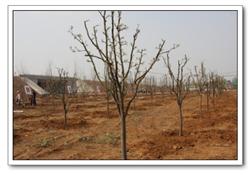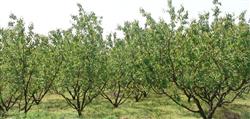Measures for fertilizer and water management of apricot trees

The main results are as follows: 1. fertilizing young trees in the first year of planting, applying fertilizer with thin application, in order to rapidly expand the crown and form a certain number of flower buds. The first fertilizer was applied when it sprouted after planting, and then topdressing once every 15 ~ 20 days, mainly urea, combined with phosphorus, potash and organic fertilizer. Stop topdressing at the beginning of July and properly control water to facilitate the formation of flowers. Base fertilizer was applied at the beginning of October, mainly organic fertilizer and phosphate fertilizer. In the second year, topdressing was applied once in late February, mid-April and late June, nitrogen fertilizer was applied with phosphorus and potassium fertilizer, and base fertilizer was applied at the beginning of October. Foliar fertilizer is directly absorbed and utilized, saving fertilizer and water, and achieving quick results. It can be sprayed in combination with the control of diseases and insect pests. Generally, 0.2% Mel 0.4% urea solution and 0.3% KH 2PO 4 solution are sprayed many times after flowering, and 0.1% Mel 0.2% borax solution and other trace elements can also be sprayed at flowering stage. Second, irrigation and drainage apricot trees should strengthen irrigation in areas with little rain and in dry seasons. The combination of spring fertilizer and irrigation before budding for the first time can ensure the needs of flowering, fruit setting and shoot growth. The second irrigation is in the hard core period (about 1 month after flowering), when the water demand is larger, coupled with the phenomenon of spring drought, so attention should be paid to watering. The third time was carried out after fruit harvest combined with fertilization to facilitate branch and leaf growth and flower bud differentiation. In addition, covering tree plates and rows with crop straw and weeds from April to August is beneficial to maintain moisture and increase soil fertility. Apricot trees are not resistant to waterlogging, so we should pay attention to drainage in rainy season, especially in flower bud differentiation period from July to August, so as to maintain proper drought, which is beneficial to flower bud differentiation.
- Prev

How to cut apricot trees in winter?
Introduction: Brown rot is also called fruit abdomen disease. In rainy years, such as serious fruit decay pests, brown rot is prevalent all the year round, resulting in a large number of rotten fruit and fruit drop, resulting in great losses. 1. Symptoms can affect flowers, leaves and fruits, especially fruits. (1) Flower organ: flower damage, browning and wilting, more.
- Next

What are the environmental requirements for the growth of apricot trees?
Apricot is a perennial deciduous fruit tree with natural growth of more than 10 meters. It has a long life, like light, cold, drought and barren. It has strong adaptability to the external environmental conditions, and the range of suitable cultivation is also very wide. The average annual temperature in the main producing areas is-5-22 ℃, and the annual accumulated temperature above 10 ℃ ≥ is 1000-6500.
Related
- Moge, come on! The staff of the peasant association in the producing area of cantaloupe were frightened when the crowd gathered.
- Causes and Solutions of low Fruit setting rate of Apple
- Symptoms and control measures of passion fruit virus disease
- Fruit growing lesson: how do apple orchards keep high yields?
- Can you build orchards in the mountains? What are the pros and cons?
- How to manage the coloring period of Crisson grape?
- This paper introduces the processing technology of two kinds of fig products.
- How much is a month for retired teachers in rural areas by 2020?
- How can strawberry planting increase sugar content? We should pay attention to management in many aspects.
- What are the cultivation techniques on how to improve the yield of golden fruit?

